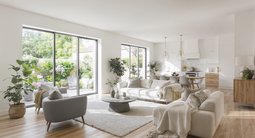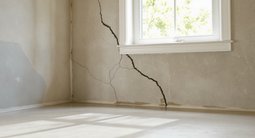TL;DR
Home renovation is shifting from guesswork to collaborative planning. AI room visualization and remodel planning apps help homeowners and pros align on scope, materials, and budget before demolition. Platforms like ReimagineHome.ai make it easy to upload your space, try multiple design directions, and share a visual plan that keeps projects on schedule.
Why Renovation Went Digital

Smart renovation planning with visual tools brings your ideas to life before any work starts.
Renovating a home is equal parts hope and stress. Designers often note that most friction—budget overruns, change orders, miscommunication—comes from an invisible gap between what people imagine and what crews can build. In 2025, that gap is closing with visual planning. We’re no longer guessing how a layout or finish will feel; we can see it first.
Here’s why this matters: when everyone can react to the same image of the future space, decisions get faster and fewer details fall through the cracks. Homeowners now test ideas in ReimagineHome.ai before hiring contractors, so scope and materials are clearer from the start. Think of it as a creative bridge—your first draft becomes visible, editable, and shareable in minutes.
Whether you’re swapping a backsplash or opening a floor plan, modern home design tools bring the renovation forward in time. You can experiment with styles, iterate on layouts, and document choices before anyone swings a hammer. The result: fewer surprises, more control, and a renovation that reflects how you really live.
How AI and collaborative tools are reshaping home renovation workflows
AI room visualization and shared planning apps reduce revisions by aligning homeowners, designers, and contractors on a visual scope before demolition. When teams review concrete images instead of abstract ideas, timelines and budgets stabilize.
Think of today’s stack as three layers: discovery, visualization, and coordination. Discovery includes inspiration boards, measurements, and a quick inventory of what stays. Visualization turns all of that into options you can actually see—layout tweaks, finish swaps, lighting changes. Coordination then packages the chosen design into a plan your contractor can price and build. Home design tools that combine these layers help projects move from vibe to build-ready.
Designers use ReimagineHome.ai as the hub for this middle layer: upload a room photo, try multiple design directions, and compare versions side by side. It’s especially powerful for kitchens and small apartments where inches matter. Because you’re deciding visually, you can avoid costly mid-project changes—like realizing the darker floor makes the room feel smaller or a peninsula blocks circulation.
How to Try It
- Upload your existing room photo to ReimagineHome.ai → explore instant before/after concepts.
- Use AI prompts to test styles (Scandi, warm modern, classic) and alternative layouts.
- Share the link with your contractor so scope and finish details are clear.
Anecdote
A young couple thought they needed to move a kitchen wall to fit an island. After uploading a photo to ReimagineHome, they tested a narrower island and a different seating angle—no structural changes required. That single visual saved weeks and thousands.
A step-by-step workflow to redesign a room with AI—from mood board to contractor handoff
A simple, repeatable workflow keeps momentum: capture your space, visualize options, confirm materials, then share a concise build brief. Following the same steps for each room reduces decision fatigue and keeps trades aligned.
Start with measurements and a quick walkthrough video so you remember quirks (sloping ceilings, odd outlets). Photograph the room in natural light. Upload a favorite shot to ReimagineHome.ai and generate a few design directions: new cabinet colors, different tile patterns, alternative furniture placements. Compare versions, shortlist two, then push each a bit further—change the backsplash, adjust flooring tone, add wall lights. You’ll quickly see which path fits your home’s light and proportions.
Once a direction wins, choose specific SKUs for the “big rocks” (flooring, counters, tile, paint, lighting). Add notes right on your visuals—grout color, trim sheen, hardware finish—so you’re not hunting that info later. Package your images and notes as a shared link or PDF for contractor pricing. Homeowners who follow this flow report fewer mid-stream changes and tighter bids because the scope is visible.
How to Try It
- Measure the room and list what stays/goes (appliances, windows, plumbing).
- Upload a clear photo to ReimagineHome → generate 3–5 versions.
- Annotate selections: paint color, tile pattern, fixture finish, lighting plan.
- Share with your contractor; ask for line-item pricing by zone (e.g., flooring, lighting, millwork).
Free vs. paid: which renovation planning tools are worth it in 2025?
Use free tools for brainstorming and basic layouts, then upgrade for accuracy, collaboration, and higher-fidelity visuals. Paid tiers earn their keep when you need consistent style control, comment threads, and exportable deliverables.
Free options help you sketch floor plans, log measurements, and create mood boards. They’re great for early-stage thinking. But when it’s time to decide between two backsplashes or confirm a galley vs. L-shaped kitchen, quality visuals and shared notes matter. That’s where a platform like ReimagineHome.ai shines: you can generate multiple looks from your real room photo, compare them side by side, and gather feedback in one place. Designers often test several tile orientations and grout colors here before ordering samples, saving weeks of back-and-forth.
Paid features to look for: version history, higher-resolution renders, accurate light and material handling, mood board export, and collaboration tools for clients and trades. If you’re planning a kitchen, bath, or open-plan living area—spaces with many finish intersections—those features tend to pay for themselves by preventing rework.
How to Try It
- Start free to mock up ideas and a rough layout.
- Upgrade when you’re deciding finishes or sharing with pros who need a clear visual brief.
- Use batch versions to A/B test key choices (oak vs. walnut, nickel vs. brass, white vs. color).
Visualize Before You Renovate
Previewing your design in your actual space reduces change orders and stress once construction begins. Seeing alternatives on your own walls makes decisions faster and more confident.
Before picking paint or breaking walls, preview your space with ReimagineHome.ai. Upload your existing photos, explore design ideas in real time, and share your visual plan with your contractor or interior designer. It’s the new “first draft” of every renovation—visual, fast, and intelligent. Use it to test cabinet colors with your lighting, try a bolder stone pattern, or confirm a furniture layout that keeps pathways clear.
How to Try It
- Photograph each room at eye level in daylight for truer color reads.
- Generate several looks; remove one, add one, until two winners remain.
- Attach product links and notes so your visuals double as a mini spec sheet.
Visualization Scenario
Upload a living room photo, prompt “modern craftsman—light oak floors, stone-clad fireplace, built-ins, warm white walls,” then iterate: swap stone color, test cabinet door styles, and audition rug sizes until the room feels balanced.
Renovation Planning FAQ
How can I plan my home renovation step by step?
Start with measurements and photos, visualize multiple options in an AI room tool, shortlist a direction, then attach product selections and notes. Your shared visual brief gives contractors a clear scope to price.
What’s the best AI tool for design collaboration?
Look for platforms that let you create versions from real room photos, comment in context, and export shareable links. Many teams prefer ReimagineHome.ai for its fast before/after visuals and easy sharing.
Can I use AI to estimate renovation budgets?
Yes—use your visual plan to request line-item bids, then pair it with a free cost estimator for sanity checks. The clearer the images and notes, the more accurate your quotes will be.
Will contractors actually use my digital designs on site?
Pros appreciate concise visuals with annotated finishes, lighting, and trim details. Share a link they can open on mobile, and keep a PDF copy in your project folder for quick reference.
From guesswork to collaboration
In 2025, home renovation planning isn’t guesswork—it’s collaboration. The most successful projects now begin with a shared visual plan: homeowners articulate goals, designers refine, and contractors price what they can see. This shift compresses timelines, reduces surprises, and—most importantly—protects your budget.
If you’re about to refresh a kitchen, open a living room, or tackle a bath, make visualization your first step. Upload your photos, try a few bold ideas, and let the best version win before the first hammer swings. Explore what’s possible at ReimagineHome.ai.
.svg)

.svg)














.png)